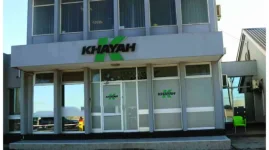Khayah Cement to Meet with Creditors Amid Financial Woes.
Khayah Cement Limited will meet with creditors on February 19. The company is undergoing voluntary corporate rescue.
At the meeting, creditors will formally prove their claims against Khayah, submitting affidavits as proof. The Master of the High Court will state the chances of rescuing the company. Creditors will also appoint a committee.
Corporate rescue is a process defined by the Insolvency Act. It involves temporarily supervising a company in financial distress, putting on hold creditors' claims, and developing a rescue plan to restructure the business. The goal is to keep the company operating and solvent. If that is not possible, the aim is to give creditors a better return than immediate liquidation.
A company's board can initiate a voluntary corporate rescue if they think the company is financially distressed but can be saved. This is different from involuntary liquidation, which creditors initiate.
Khayah, formerly Lafarge, began corporate rescue proceedings. It cited "considerable challenges in meeting some of its obligations to creditors." The company said major equipment breakdowns hampered its ability to meet obligations. The breakdowns caused significant loss of production and required large sums of money for repairs.
In 2023, Khayah mothballed its kiln. The kiln is essential for producing clinker at competitive costs, a major raw material in cement production. After mothballing the kiln, Khayah had to buy more expensive clinker, which supported a new "grinding station" business model.
Trade restrictions on a member of the consortium that bought a controlling stake in Khayah also caused problems. Financial institutions withdrew critical support and services, and key suppliers stopped providing services. This made purchasing goods and services very expensive.
Creditors became agitated due to outstanding debts, and some took legal action. To avoid negative consequences, Khayah had to make burdensome payment plans. This drained working capital from current operations and constrained working capital, recovery, and profitability.
Khayah Cement Limited will meet with creditors on February 19. The company is undergoing voluntary corporate rescue.
At the meeting, creditors will formally prove their claims against Khayah, submitting affidavits as proof. The Master of the High Court will state the chances of rescuing the company. Creditors will also appoint a committee.
Corporate rescue is a process defined by the Insolvency Act. It involves temporarily supervising a company in financial distress, putting on hold creditors' claims, and developing a rescue plan to restructure the business. The goal is to keep the company operating and solvent. If that is not possible, the aim is to give creditors a better return than immediate liquidation.
A company's board can initiate a voluntary corporate rescue if they think the company is financially distressed but can be saved. This is different from involuntary liquidation, which creditors initiate.
Khayah, formerly Lafarge, began corporate rescue proceedings. It cited "considerable challenges in meeting some of its obligations to creditors." The company said major equipment breakdowns hampered its ability to meet obligations. The breakdowns caused significant loss of production and required large sums of money for repairs.
In 2023, Khayah mothballed its kiln. The kiln is essential for producing clinker at competitive costs, a major raw material in cement production. After mothballing the kiln, Khayah had to buy more expensive clinker, which supported a new "grinding station" business model.
Trade restrictions on a member of the consortium that bought a controlling stake in Khayah also caused problems. Financial institutions withdrew critical support and services, and key suppliers stopped providing services. This made purchasing goods and services very expensive.
Creditors became agitated due to outstanding debts, and some took legal action. To avoid negative consequences, Khayah had to make burdensome payment plans. This drained working capital from current operations and constrained working capital, recovery, and profitability.












